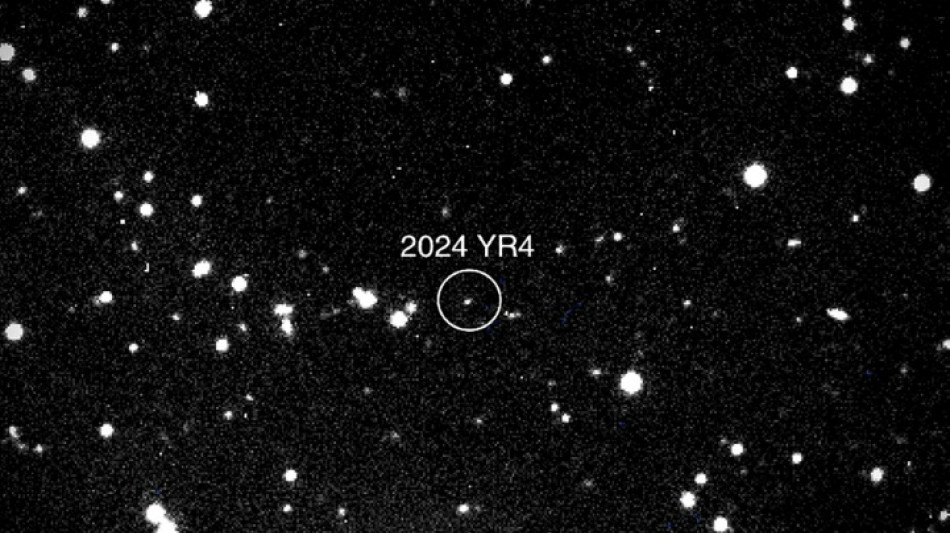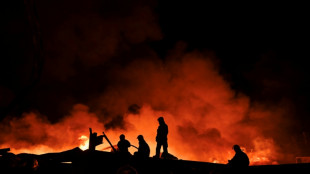
-
 China authorities approve arrest of ex-abbot of Shaolin Temple
China authorities approve arrest of ex-abbot of Shaolin Temple
-
Clashes erupt in Mexico City anti-crime protests, injuring 120

-
 India, without Gill, 10-2 at lunch chasing 124 to beat S.Africa
India, without Gill, 10-2 at lunch chasing 124 to beat S.Africa
-
Bavuma fifty makes India chase 124 in first Test

-
 Mitchell ton lifts New Zealand to 269-7 in first Windies ODI
Mitchell ton lifts New Zealand to 269-7 in first Windies ODI
-
Ex-abbot of China's Shaolin Temple arrested for embezzlement

-
 Doncic scores 41 to propel Lakers to NBA win over Bucks
Doncic scores 41 to propel Lakers to NBA win over Bucks
-
Colombia beats New Zealand 2-1 in friendly clash

-
 France's Aymoz wins Skate America men's gold as Tomono falters
France's Aymoz wins Skate America men's gold as Tomono falters
-
Gambling ads target Indonesian Meta users despite ban

-
 Joe Root: England great chases elusive century in Australia
Joe Root: England great chases elusive century in Australia
-
England's Archer in 'happy place', Wood 'full of energy' ahead of Ashes

-
 Luxury houses eye India, but barriers remain
Luxury houses eye India, but barriers remain
-
Budget coffee start-up leaves bitter taste in Berlin

-
 Reyna, Balogun on target for USA in 2-1 win over Paraguay
Reyna, Balogun on target for USA in 2-1 win over Paraguay
-
Japa's Miura and Kihara capture Skate America pairs gold

-
 Who can qualify for 2026 World Cup in final round of European qualifiers
Who can qualify for 2026 World Cup in final round of European qualifiers
-
UK to cut protections for refugees under asylum 'overhaul'

-
 England's Tuchel plays down records before final World Cup qualifier
England's Tuchel plays down records before final World Cup qualifier
-
Depoortere double helps France hold off spirited Fiji

-
 Scotland face World Cup shootout against Denmark after Greece defeat
Scotland face World Cup shootout against Denmark after Greece defeat
-
Hansen hat-trick inspires Irish to record win over Australia

-
 Alcaraz secures ATP Finals showdown with 'favourite' Sinner
Alcaraz secures ATP Finals showdown with 'favourite' Sinner
-
UK to cut protections for refugees under asylum 'overhaul': govt

-
 Spain, Switzerland on World Cup brink as Belgium also made to wait
Spain, Switzerland on World Cup brink as Belgium also made to wait
-
Sweden's Grant leads by one at LPGA Annika tournament

-
 Scotland cling to hopes of automatic World Cup qualification despite Greece defeat
Scotland cling to hopes of automatic World Cup qualification despite Greece defeat
-
Alcaraz secures ATP Finals showdown with great rival Sinner

-
 England captain Itoje savours 'special' New Zealand win
England captain Itoje savours 'special' New Zealand win
-
Wales's Evans denies Japan historic win with last-gasp penalty

-
 Zelensky renews calls for more air defence after deadly strike on Kyiv
Zelensky renews calls for more air defence after deadly strike on Kyiv
-
NBA's struggling Pelicans sack coach Willie Green

-
 Petain tribute comments raise 'revisionist' storm in France
Petain tribute comments raise 'revisionist' storm in France
-
Spain on World Cup brink as Belgium also made to wait

-
 Spain virtually seal World Cup qualification in Georgia romp
Spain virtually seal World Cup qualification in Georgia romp
-
M23, DR Congo sign new peace roadmap in Doha

-
 Estevao, Casemiro on target for Brazil in Senegal win
Estevao, Casemiro on target for Brazil in Senegal win
-
Ford steers England to rare win over New Zealand

-
 Massive march in Brazil marks first big UN climate protest in years
Massive march in Brazil marks first big UN climate protest in years
-
Spain rescues hundreds of exotic animals from unlicensed shelter

-
 Huge fire sparked by explosions near Argentine capital 'contained'
Huge fire sparked by explosions near Argentine capital 'contained'
-
South Africa defy early red card to beat battling Italy

-
 Sinner beats De Minaur to reach ATP Finals title match
Sinner beats De Minaur to reach ATP Finals title match
-
Zelensky vows overhaul of Ukraine's scandal-hit energy firms

-
 South Africa defy early red card to beat Italy
South Africa defy early red card to beat Italy
-
Alex Marquez claims Valencia MotoGP sprint victory

-
 McIlroy shares lead with Race to Dubai title in sight
McIlroy shares lead with Race to Dubai title in sight
-
Climate protesters rally in Brazil at COP30 halfway mark

-
 Spike Lee gifts pope Knicks jersey as pontiff meets film stars
Spike Lee gifts pope Knicks jersey as pontiff meets film stars
-
BBC caught in crossfire of polarised political and media landscape


A 'city-killer' asteroid might hit Earth -- how worried should we be?
A colossal explosion in the sky, unleashing energy hundreds of times greater than the Hiroshima bomb. A blinding flash nearly as bright as the Sun. Shockwaves powerful enough to flatten everything for miles.
It may sound apocalyptic, but a newly detected asteroid nearly the size of a football field now has a greater than one percent chance of colliding with Earth in about eight years.
Such an impact has the potential for city-level devastation, depending on where it strikes.
Scientists aren't panicking yet, but they are watching closely.
"At this point, it's 'Let's pay a lot of attention, let's get as many assets as we can observing it,'" Bruce Betts, chief scientist of The Planetary Society, told AFP.
- Rare finding -
Dubbed 2024 YR4, the asteroid was first spotted on December 27, 2024, by the El Sauce Observatory in Chile. Based on its brightness, astronomers estimate it is between 130 and 300 feet (40–90 meters) wide.
By New Year's Eve, it had landed on the desk of Kelly Fast, acting planetary defense officer at US space agency NASA, as an object of concern.
"You get observations, they drop off again. This one looked like it had the potential to stick around," she told AFP.
The risk assessment kept climbing, and on January 29, the International Asteroid Warning Network (IAWN), a global planetary defense collaboration,issued a memo.
According to the latest calculations from NASA's Jet Propulsion Laboratory, there is a 1.6 percent chance the asteroid will strike Earth on December 22, 2032.
If it does hit, possible impact sites include over the eastern Pacific Ocean, northern South America, the Atlantic Ocean, Africa, the Arabian Sea, and South Asia, the IAWN memo states.
2024 YR4 follows a highly elliptical, four-year orbit, swinging through the inner planets before shooting past Mars and out toward Jupiter.
For now, it's zooming away from Earth -- its next close pass won't come until 2028.
"The odds are very good that not only will this not hit Earth, but at some point in the next months to few years, that probability will go to zero," said Betts.
A similar scenario unfolded in 2004 with Apophis, an asteroid initially projected to have a 2.7 percent chance of striking Earth in 2029. Further observations ruled out an impact.
- Destructive potential -
The most infamous asteroid impact occurred 66 million years ago, when a six-mile-wide space rock triggered a global winter, wiping out the dinosaurs and 75 percent of all species.
By contrast, 2024 YR4 falls into the "city killer" category.
"If you put it over Paris or London or New York, you basically wipe out the whole city and some of the environs," said Betts.
The best modern comparison is the 1908 Tunguska Event, when an asteroid or comet fragment measuring 30-50 meters exploded over Siberia, flattening 80 million trees across 770 square miles (2,000 square kilometers).
Like that impactor, 2024 YR4 would be expected to blow up in the sky, rather than leaving a crater on the ground.
"We can calculate the energy... using the mass and the speed," said Andrew Rivkin, a planetary astronomer at Johns Hopkins Applied Physics Laboratory.
For 2024 YR4, the explosion from an airburst would equal around eight megatons of TNT -- more than 500 times the power of the Hiroshima bomb.
If it explodes over the ocean, the impact would be less concerning, unless it happens near a coastline triggering a tsunami.
- We can stop it -
The good news, experts stress, is that we have plenty of time to prepare.
Rivkin led the investigation for NASA's 2022 DART mission, which successfully nudged an asteroid off its course using a spacecraft -- a strategy known as a "kinetic impactor."
The target asteroid posed no threat to Earth, making it an ideal test subject.
"I don't see why it wouldn't work" again, he said. The bigger question is whether major nations would fund such a mission if their own territory wasn't under threat.
Other, more experimental ideas exist.
Lasers could vaporize part of the asteroid to create a thrust effect, pushing it off course. A "gravity tractor," a large spacecraft that slowly tugs the asteroid away using its own gravitational pull, has also been theorized.
If all else fails, the long warning time means authorities could evacuate the impact zone.
"Nobody should be scared about this," said Fast. "We can find these things, make these predictions and have the ability to plan."
Q.Najjar--SF-PST




